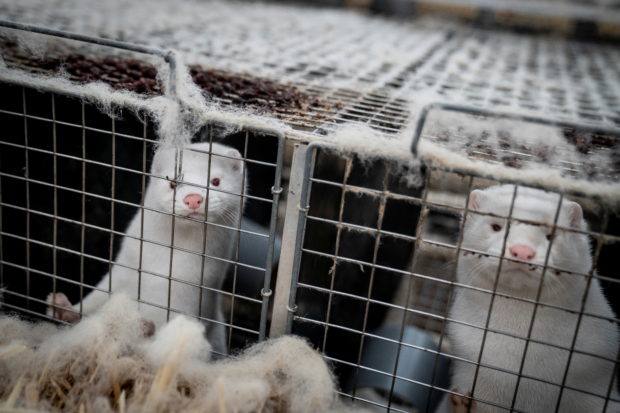Coronavirus kills 15,000 US mink, as Denmark prepares for nationwide cull

FILE PHOTO: Mink are seen at the farm of Henrik Nordgaard Hansen and Ann-Mona Kulsoe Larsen near Naestved, Denmark, November 6, 2020. Ritzau Scanpix/Mads Claus Rasmussen via REUTERS
CHICAGO — More than 15,000 mink in the United States have died of the coronavirus since August, and authorities are keeping about a dozen farms under quarantine while they investigate the cases, state agriculture officials said.
Global health officials are eying the animals as a potential risk for people after Denmark last week embarked on a plan to eliminate all of its 17 million mink, saying a mutated coronavirus strain could move to humans and evade future COVID-19 vaccines.
The U.S. states of Utah, Wisconsin and Michigan – where the coronavirus has killed mink – said they do not plan to cull animals and are monitoring the situation in Denmark.
“We believe that quarantining affected mink farms in addition to implementing stringent biosecurity measures will succeed in controlling SARS-CoV-2 at these locations,” the U.S. Department of Agriculture told Reuters on Tuesday.
The USDA said it is working with the U.S. Centers for Disease Control and Prevention, state officials and the mink industry to test and monitor infected farms.
The United States has 359,850 mink bred to produce babies, known as kits, and produced 2.7 million pelts last year. Wisconsin is the largest mink-producing state, followed by Utah.
Sick mink in Wisconsin and Utah were exposed to people with probable or confirmed COVID-19 cases, the USDA said. In Michigan it is still unknown if the mink were infected by humans, according to the agency.
In Utah, the first U.S. state to confirm mink infections in August, about 10,700 mink have died on nine farms, said Dean Taylor, state veterinarian.
“On all nine, everything is still suggesting a one-way travel from people to the minks,” he said.
Coronavirus testing has been done on mink that die and randomly on the affected farms, Taylor said. Like people, some mink are asymptomatic or mildly affected, he said.
The CDC said it was supporting states’ investigations into sick mink, including testing of animals and people.
“These investigations will help us to learn more about the transmission dynamics between mink, other animals around the farms and people,” the CDC said. “Currently, there is no evidence that animals play a significant role in the spread of SARS-CoV-2 to people.”
Coronavirus is thought to have first jumped to humans from animals in China, possibly via bats or another animal at a food market in Wuhan, although many outstanding questions remain.
Monitoring U.S. mink for virus symptoms and quarantining infected farms should limit the disease’s spread if cases are caught early, said Richard Webby, a virologist at St. Jude Children’s Research Hospital in Memphis.
“I’m fairly confident that as long as they have that surveillance going and it’s strong enough, then they should be able to prevent the spread,” he said.
U.S. authorities are urging farmers to wear protective gear like masks and gloves when handling mink to avoid infecting the animals.
In Wisconsin, about 5,000 mink have died on two farms, State Veterinarian Darlene Konkle said.
One farm is composting the dead mink to dispose of the carcasses without spreading the virus, Konkle said. Authorities are working with the second farm to determine how to dispose of the mink, and dead animals are being kept in a metal container in the meantime, she said.
Michigan declined to disclose how many mink have died, citing privacy rules.
State officials said they are working with the USDA to determine whether farmers can sell the pelts of infected mink. The pelts are used to make fur coats and other items.
The coronavirus has also infected cats, dogs, a lion and a tiger, according to the USDA. Experts say mink appear to be the most susceptible animal so far.
For more news about the novel coronavirus click here.
What you need to know about Coronavirus.
For more information on COVID-19, call the DOH Hotline: (02) 86517800 local 1149/1150.
The Inquirer Foundation supports our healthcare frontliners and is still accepting cash donations to be deposited at Banco de Oro (BDO) current account #007960018860 or donate through PayMaya using this link.